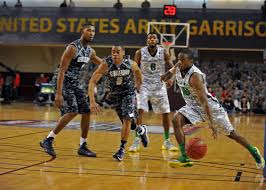Sep 1, 2017Technique Trumps All
Adam Linens, MS, CSCS, ATC, PES, CES, is an Assistant Strength and Conditioning Coach at the University of Oregon, working specifically with the men’s basketball team. He has also worked with the NBA’s Atlanta Hawks and Cleveland Cavaliers and the WNBA’s Atlanta Dream. Below he answers questions on training speed and agility.
What’s your overall philosophy regarding speed and agility?
Linens: In my experience, all athletes want to do is go fast. But speed and agility training is not about how fast a player can accelerate, it’s about how fast they can stop and then reaccelerate multiple times. When NBA players get to the final years of their careers, they have no problems starting — they have problems stopping, landing, and changing direction. Those skills require the most eccentric strength, so I try to instill them early in my players’ careers.
That being said, much of what I teach is based on linear speed development. Although basketball athletes don’t need a ton of linear speed training — since they play a change-of-direction sport — good technique for linear speed will transfer to change-of-direction work and other movements.

How do you improve speed and agility?
Linens: I like to use ladders and hurdles to instill proper balance, body positioning, linear speed, and lateral quickness. We start with specific ladder drills to teach forward-to-backward change of direction, hip rotations, and pivoting. Then, I’ll get into more advanced drills with hurdles and cones. After that, we progress to reactionary training, where I use numbered cones, colored cones, or pointing in different directions to get athletes to react. During these sessions, I also like to use lateral resistors around their ankles to strengthen their hips.
What role does technique have in speed and agility training?
Linens: Technique trumps everything. Some coaches overload athletes with repetitions or resistance when their movements aren’t correct to begin with. This only ingrains bad habits.
Instead, I’ll teach a drill and make sure athletes have good technique before moving forward. After they’ve gotten proficient in the drill, we’ll add some resistance. However, I don’t add so much resistance that it makes the movement look sloppy. My general rule is: The more sport-specific a drill, the lighter the resistance.
How do you make speed and agility training sport specific?
Linens: I take the sport, break it down into different movements, and then teach corresponding pieces of it through a drill. I’m not teaching basketball skills, but our speed and agility training can focus on footwork related to an open step or crossover step that will help players drive to the basket or shuffle on defense.
What role does strength training play in your speed and agility work?
Linens: Strength training enhances speed and agility, and speed and agility enhance strength training. If you think of different concentric and explosive speed movements, they all require triple extension. We focus on triple extension in a lot of the exercises that we do, such as squat variations, dumbbell variations, kettlebell swings, arm dumbbell snatches, and clean variations.
To enhance change of direction, we emphasize single-leg exercises in the weightroom. I try to get athletes comfortable with balancing, exploding, controlling, and decelerating on one leg. Some of our exercises include variations of step-ups and lunges, single-leg Romanian dead lifts, and rear-foot elevator squats, as well as dumbbell split jerks.
Top Ad ZoneID:
49890



